Table of contents || Previous section || Next section || Glossary || PDF document
 |
Seven major water-quality characteristics were evaluated for stream sites in each NAWQA Study Unit. Summary scores for each characteristic were computed for all sites that had adequate data. Scores for each site in the Red River of the North Basin were compared with scores for all sites sampled in the 20 NAWQA Study Units during 1992-95. Results are summarized by percentiles; higher percentile values generally indicate poorer quality compared with other NAWQA sites. Water-quality conditions at each site also are compared to established criteria for protection of aquatic life. Applicable criteria are limited to nutrients and pesticides in water, and semivolatile organic compounds, organochlorine pesticides, and PCBs in sediments. (Methods used to compute rankings and evaluate aquatic-life criteria are described by Gilliom and others, in press.) |
| NUTRIENTS in water | |
|---|---|
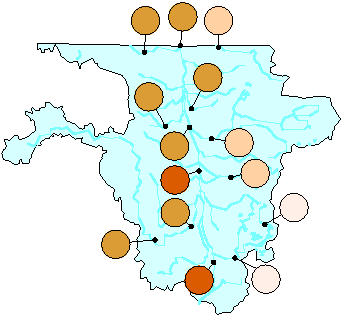 |
Nearly all streams that drain the eastern parts of the Study Unit contained nutrient concentrations that were lower than the national median for the other Study Units. Streams that drain the western and central areas were higher than the national median. The distribution of cropland and soils helps explain this nutrient pattern. |
| PESTICIDES in water | |
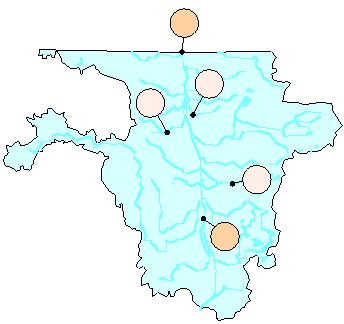 |
Pesticide concentrations in the Red River and its tributaries are lower than most concentrations in streams from other NAWQA Study Units. The Study Unit had the highest percentage of agricultural cropland among other Study Units and is in the lowest quartile in terms of pesticide concentrations.
|
| ORGANOCHLORINE PESTICIDES and PCBs in bed sediment and biological tissue | |
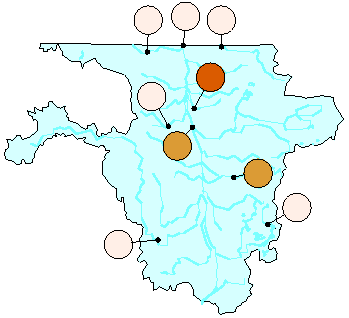 |
Where detected, DDT concentrations were typical of other minimally contaminated areas in the other NAWQA Study Units. Organochlorine concentrations in fish usually were low in the Study Unit and were low on a national basis. However, PCB concentrations in some fish from this area prompt State fish-consumption advisories. PCBs and many organochlorine compounds were banned in the 1970's. |
| TRACE ELEMENTS in bed sediment | |
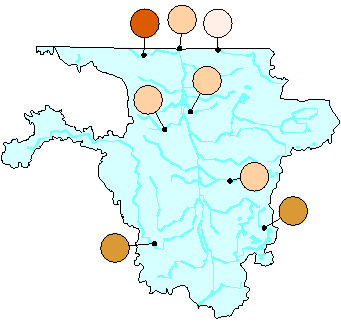 |
Trace elements in sediments were usually typical of other NAWQA Study Units and reflect natural concentrations. The site with the highest concentrations likely reflects higher natural concentrations of trace elements associated with shale outcroppings in that area. |
| SEMIVOLATILE ORGANIC COMPOUNDS in bed sediment | |
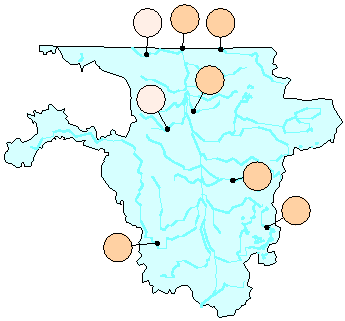 |
This broad group of chemicals includes PAHs (polycyclic aromatic hydrocarbons, which are both components of fossil fuels and by-products of combustion), phenols (industrial solvents), and phthalates (often used as plasticizers or solvents). concentrations of these compounds were below the median of other NAWQA Study Units. |
| STREAM HABITAT DEGRADATION | |
 |
Stream habitat in the basin was generally poor compared to the other NAWQA Study Units. Almost all streams in the basin have been modified through dams, ditching, or channelization and erosion due to unstable banks. Agricultural practices that leave riverine wetlands and intact riparian zones with naturally dense vegetation seem to provide a degree of instream habitat protection and enhance fish communities. |
| FISH COMMUNITIES DEGRADATION | |
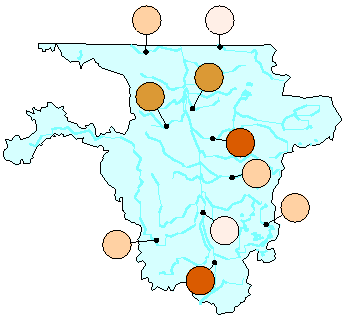 |
Compared to other NAQWA Study Units, fish species composition varied from poor to good, depending on area within the basin. Tributary streams outside of the central subregion tended to have better composition of species. Tributary streams in the central subregion and the Red River were dominated by introduced carp but still contained numerous species. It is difficult to distinguish the relative importance of natural compared to land-use factors due to the interactions where land use affects habitat and waterquality. |
The significant amount of cropland in the Red River Basin Study Unit has resulted in elevated concentrations of nutrients and low concentrations of pesticides in many streams. However, comparison to the NAWQA sites nationwide shows that nutrient concentrations were not exceptionally high and pesticide detections were relatively low.